#indian women winter dresses
Explore tagged Tumblr posts
Text
Makar Sankranti, a vibrant harvest festival, is celebrated with great enthusiasm across India, marking the transition of the sun into the zodiac sign of Capricorn. This significant day, falling every year on January 14th, symbolizes new beginnings, prosperity, and a deep connection with nature’s rhythms. Whether you’re preparing for the traditional celebrations or looking to bring in the festivities with a stylish flair, Makar Sankranti 2025 offers the perfect occasion to embrace cultural heritage with a modern twist.
#buy velvet kurti online in india#buy winter wear for women#designer ethnic sets for ladies#designer indian ethnic wear online#dress code for makar sankranti#dresses online shopping#ethnic sets with dupatta#ethnic suit set for women#ethnic wear collection#facts about makar sankranti#festival dresses for ladies#festive ethinc sets#festive wear anarkali suits#festive wear for women#festive wear kurta set for women#festive wear kurti set#indian festival look#indian festive wear online#kurta pant dupatta set#kurti collection#kurti shopping#kurtis & kurta collection#ladies suit set online#latest suit set for women#makar sankranti dressing ideas#makar sankranti ethnic collection#makar sankranti festival#makar sankranti harvest festival#makar sankranti outfit#makar sankranti outfit ideas
0 notes
Text
15 Pack Combo Flower Seeds for Your Home Garden | Winter | All-Season Varieties, Perfect for Indian Winters |
Price: (as of – Details) From the brand Fresh & Pure Flower Seeds Fresh & Pure Flower Seeds has been handpicked by our expert’s team to provide the most complete and fresh Flower garden Seeds. Since year 2015, we are providing high quality product’s to our customers. Including NON GMO and Proudly produced in INDIA Vegetables Seeds, Flowers Seeds, Herbs Seeds, Trees Seeds & Fruits Seeds. Seeds…

View On WordPress
#a summer winter and monsoon story book#AllSeason#baby blanket for winter 0- 2 years#baby winter cap 0-6 months#baby winter clothes 6-12 months#baby winter dress#best winter moisturizer for dry skin#blanket for winter double size#blanket for winter double size soft#blanket single bed for winter#blanket single bed for winter heavy#blankets for winter double bed#cap for winter men#cold cream for winter 500ml#Combo#Flower#Garden#heater for winter in home#heavy winter blanket#heavy winter blanket double bed#heavy winter quilt#heavy winter quilt double bed#HOME#hoodie for men winter wear#Indian#jacket for men winter wear#jacket for women winter wear#jockey winter innerwear for men#kidzee winter uniform#korean winter outfits for girls
0 notes
Text
When it comes to ethnic fashion, much emphasis is often placed on the beauty of the top or the kurti. But a well-rounded ethnic ensemble isn't complete without the right bottom wear. The right choice of bottoms can enhance the overall look, add flair, and ensure comfort. In this guide, we explore the diverse world of bottom wear in ethnic attires, from traditional classics to contemporary trends.
#branded kurtis online sale#buy latest bottom wear for women#buy winter wear for women#chanderi ethnic kurti and pant set#chanderi indian ethnic suit designs#cigarette pants for ladies with kurta#cigarette pants with kurta#daily use pants for ladies#daily wear pants for ladies#different types of bottom wear#different types of pants for kurtis#ethnic bottom wear#ethnic dress designs#ethnic dresses online#ethnic sets with dupatta#ethnic sets with pant#ethnic wear for women online#indian festival look#kurta design woman#kurta pant dupatta set#kurta sets with pants#ladies cotton pants for kurtis#ladies kurti design#ladies kurti designer#ladies kurtis online sale#ladies pant trouser#latest bottom wear for ladies#latest trends in bottom wear#stylish winter wear for ladies#traditional kurtis for ladies
0 notes
Text
TTEOTM Easter Eggs Part 3 - Costume and Makeup Details
I love beautiful costumes, but even more when they tell a story! Here are a few of my observations. Did you spot anything else? (Spoilers!)
(1) The two outfits Ye Xiwu gifted Tantai Jin are both quilted. The purple costume is particularly unusual in that it's constructed like a blanket. In contrast, all his clothing in the hostage prince arc are not quite thick enough for Sheng kingdom's harsh winters. Ye Xiwu is literally bringing warmth to his life.

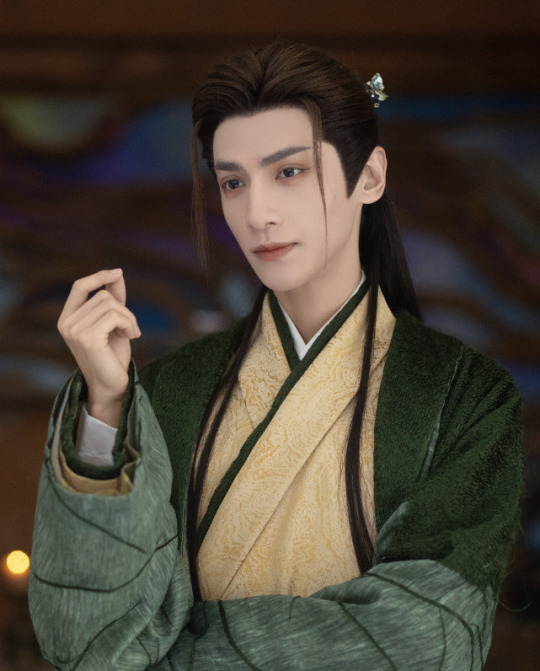
(2) TTJ and YXW wear similar costumes in their two love scenes - (1) Ep 2 - YXW's imagination of the drugged affair which led to their marriage and (2) Ep 39, where they finally consummated their marriage on screen. YXW wears the same pink costume. TTJ in different but identical-looking mustard yellow costumes.
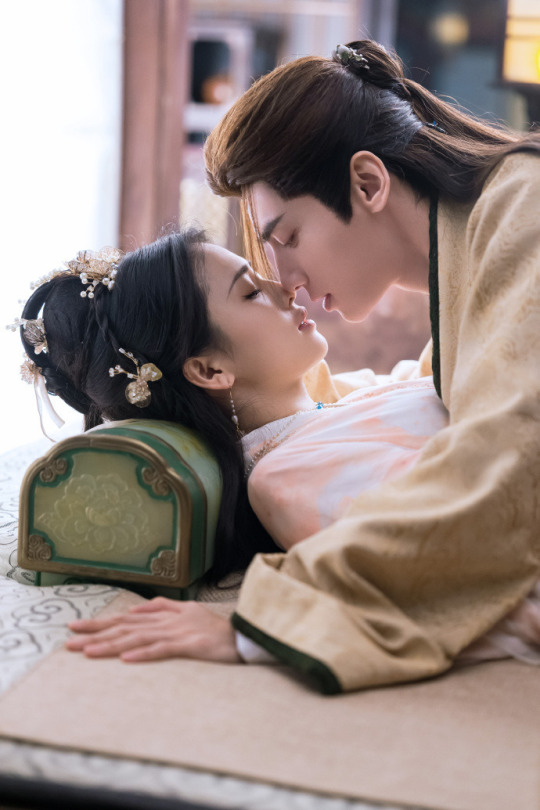
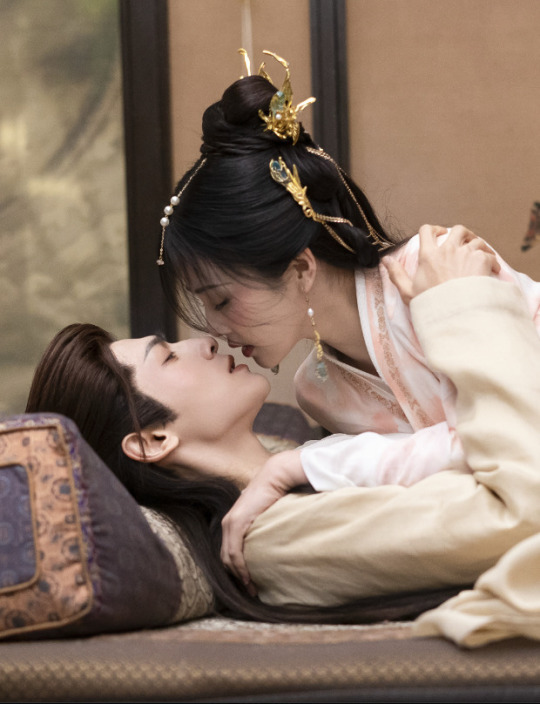
(3) Some viewers have criticized Ye Xiwu for not taking off hair accessories before going to bed, chalking it up to lazy filmmaking. This is not necessarily the case. In ancient China, upper class women did sleep with their hair-do and manage to keep elaborate designs in tack. How? By resting her neck, not her head, on the pillow.
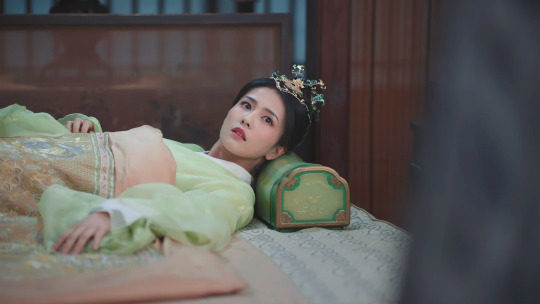
Ye Xiwu / Li Susu does go without hair accessories in a few occasions: when she is traveling, ill, depressed, and in mourning. It is most likely a creative choice to create a contrast between moments where her character is in control and powerful vs. vulnerable.
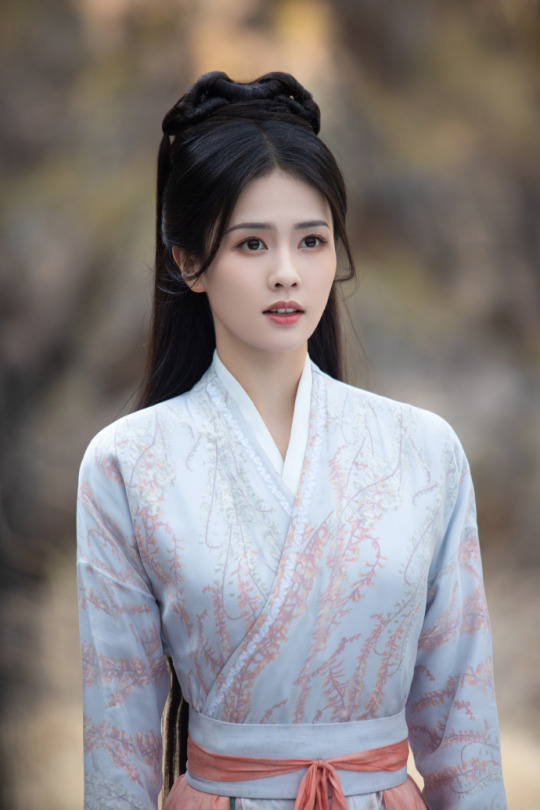
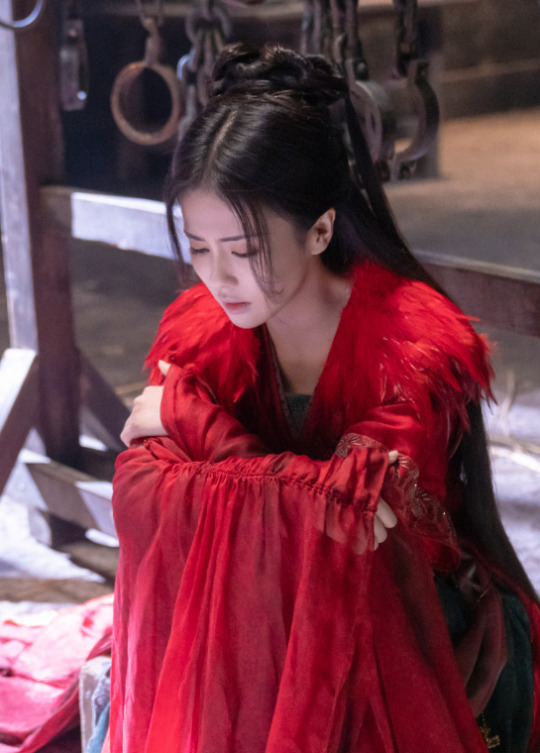

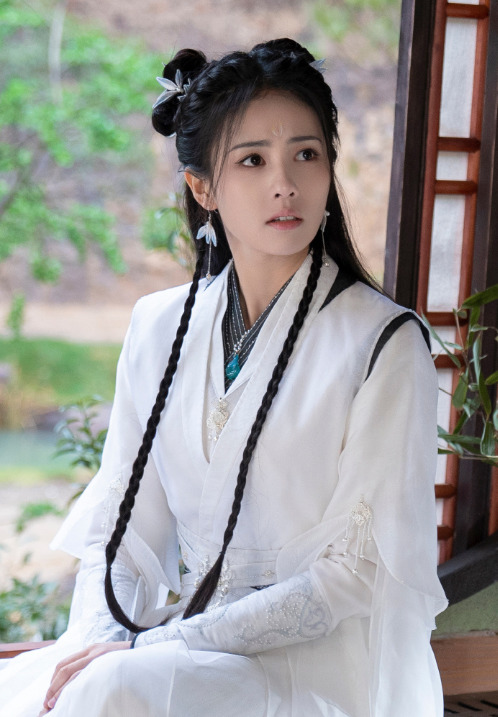
(4) All of Tantai Jin's female lieutenants wear red, from Pianran (after she starts working for him) to Siying and Monu. In fact, so does Tantai Minglang's lieutenant Fuyu. Red appears to be the career woman's color in this world!


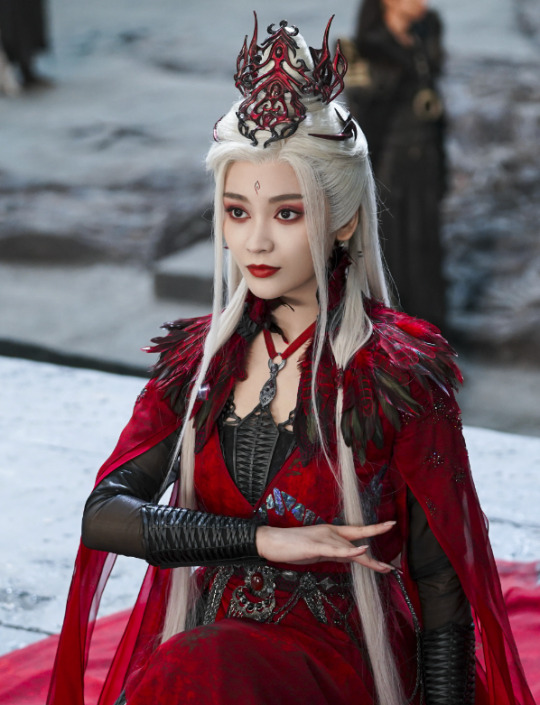

(5) After Mingye falls in love with Sangjiu, he adds the red waist scarf belt that's part of his wedding dress on top of his normally blue outfit.
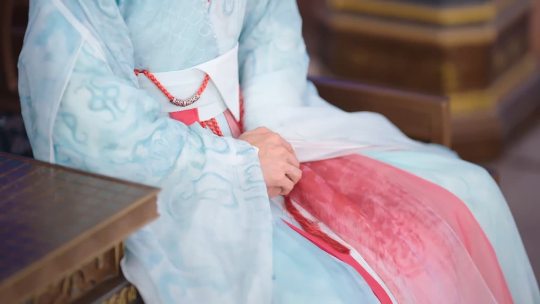
(6) The costume that Cang Jiumin (left) wears when refining the Dragonheart Shield echoes Mingye's costume (right) through the red/blue colors and collar design, reinforcing the connection between the two characters.
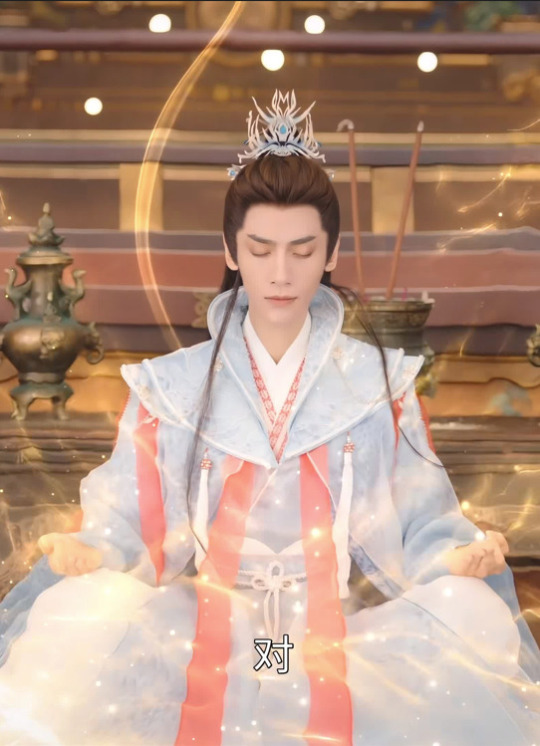
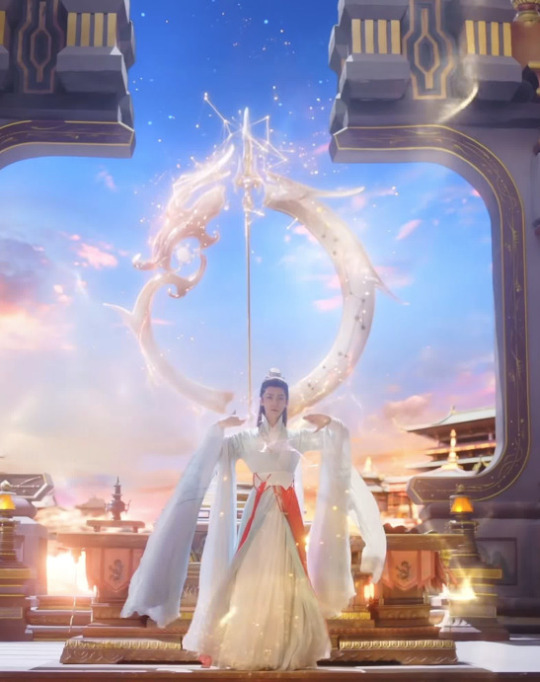
(7) The costumes in Bo're dream hint at the characters' true forms:
Mingye (dragon): dragonscale armour & patterned clothing
Sangjiu & Sangyou (clams): pearls & shell motifs
Tianhuan (snake): gold serpent hair crown & bracelets
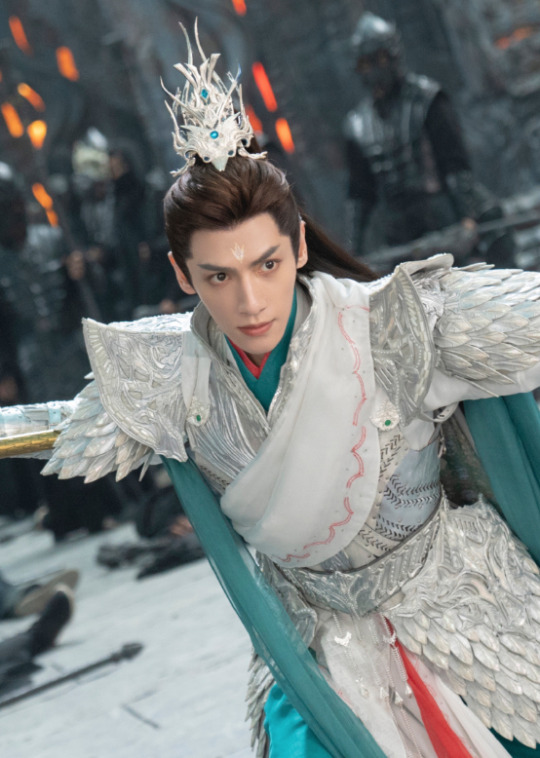


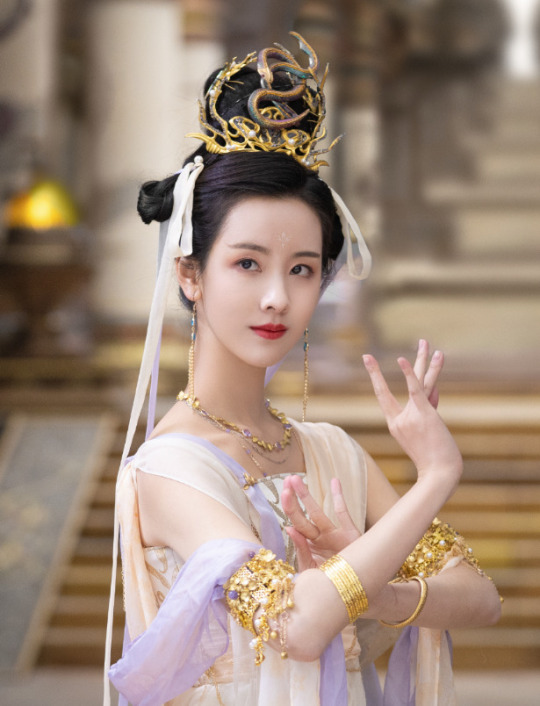
(8) Throughout the drama, only characters in the Upper Immortal Realm go full Dunhuang Feitian style, characterized by bandeaus, scarves, layers of drapery, sleeveless (similar to Indian clothing).

The style is used in formal occasions or to confer power or godliness. For example, Sangjiu goes Dunhuang with sleeveless draping outfits at her wedding and after she goes dark.
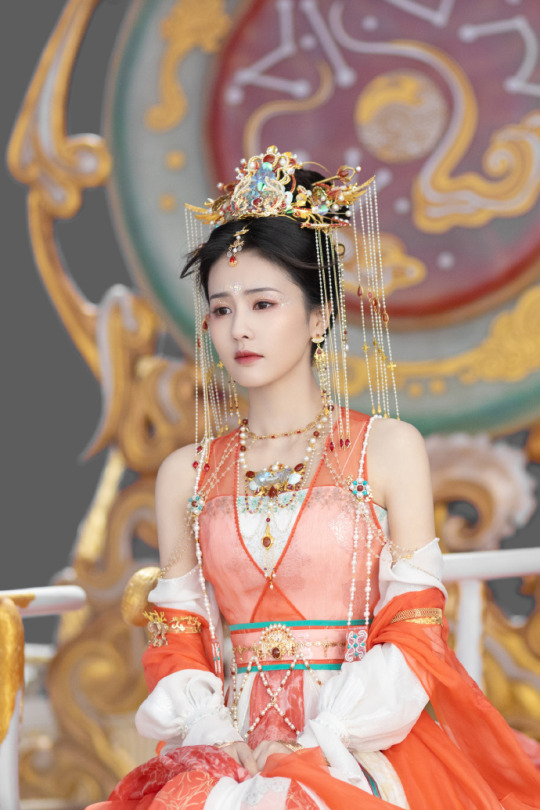
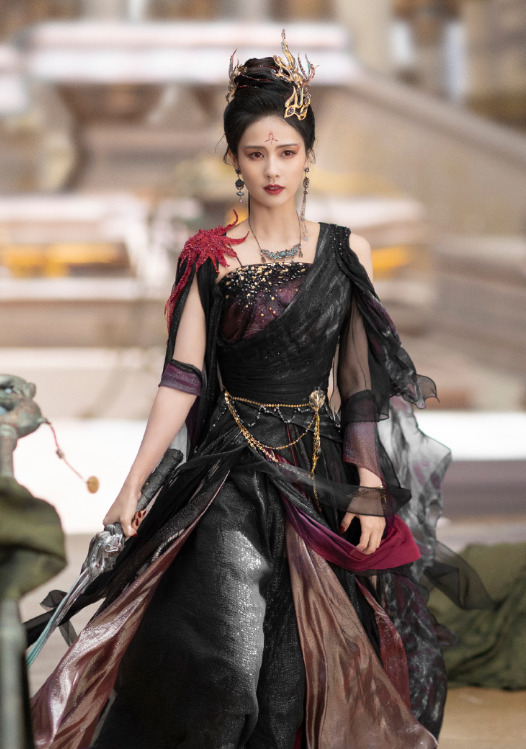
Similarly, when Susu and Tantai Jin become gods at the finale, they also take on a new Dunhuang-style outfit. In fact, the multi-color drapery of Tantai Jin's outfit seem to be an amalgamation of the fabric used in the twelve gods' outfits.
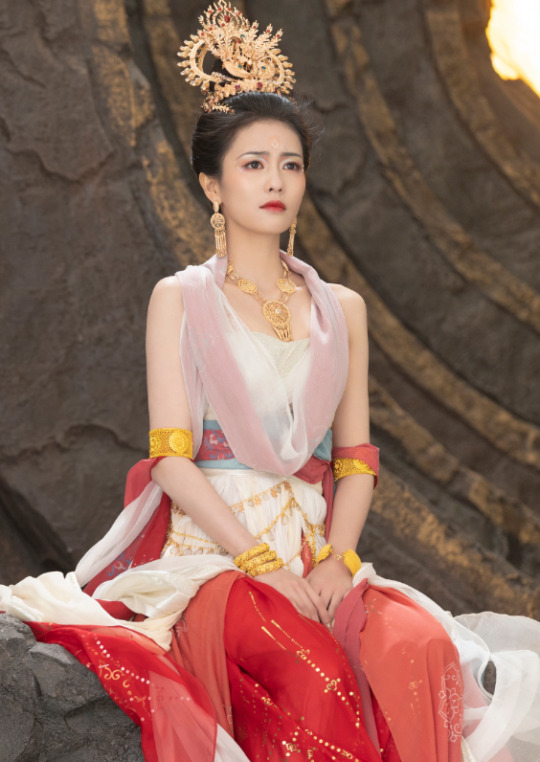
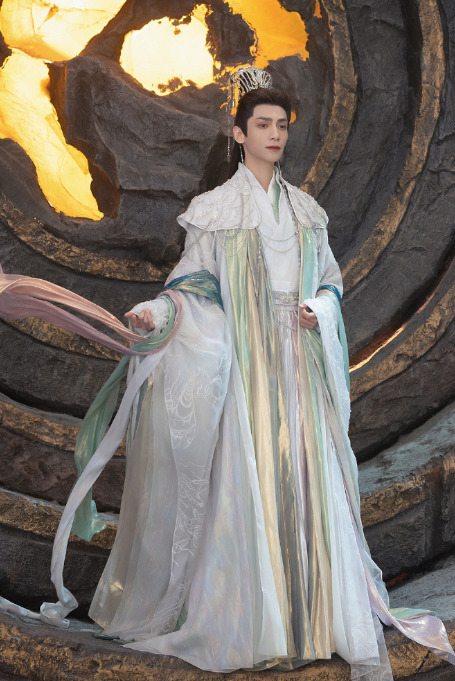
(9) Members of the Moon Tribe all wear long wavy hair, chunky metal and coin ornaments, and hair braiding.
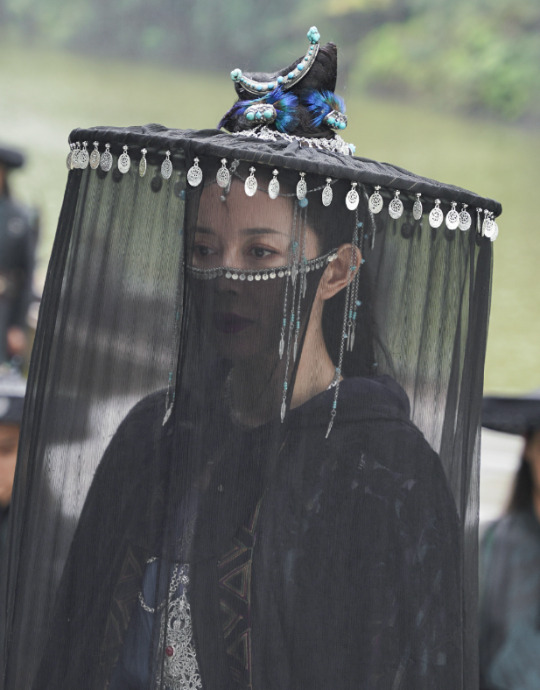

Tantai Jin follows the dress code when he stays with the Moon Tribe before entering the spiritual dimension.

Guess who also loves his wavy hair, metallic accessories, and leather? Of course it's the Ancient Devil God, again reminding viewers of his connection to the tribe.
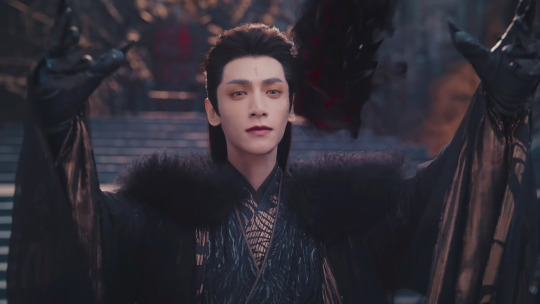
Bonus: Luo Yunxi mentioned in an interview that his characters (hostage prince, emperor, Mingye, Devil Gods) all have different hairpieces/wigs. He had to take off and reglue his hair between scenes.
#till the end of the moon#luo yunxi#black moonlight holds the be script#cdrama#chang yue jin ming#chinese drama#tteotm#tantai jin#bai lu#ye xiwu#mingye#sangjiu
346 notes
·
View notes
Note
about the dawn court people being east Asia inspired - feyre says something when she sees Nuan at the high lord meeting about how Amren must have chosen a fae form similar to Nuan's bloodline. If Amren is east-asian coded, so is Nuan and thesan too, having at least one parent hailing from xian (am i reading too far into xian sounding so stereotypical, maybe, do i care rn, no). they also say that a majority of the dawn court hails from xian. thesan is supposed to have brown skin (again, please give a better descriptor) so he's mixed.
no one's clothes or architecture reflects anything concrete regarding their inspiration and its such a hodge podge it's so painful to try to discern where the differentiation between courts are. Spring court - because of the name tamlin correlates to a myth about a guy named tam lin who is kind of being held captive by the queen of faeries who needs to be rescued by his mortal lover that he met like suuuper recently, I'm placing the spring court in a place that reflects a medieval scotland. clothes are fairly accurate not in detail but in the sense of material and idk just general existence (women wear dress, man wear breeches, idk) I love that! so simple! Everything makes sense! So then why in dawn are we having technological advances in a steampunk sort of way and similar "old fashioned" clothes to spring, but then in the night court (velaris, the other's i think are fairly period accurate), there are all these advancements in fashion like leggings and pullover sweaters and whatever else she's wearing in the last two books, yet they have the same tech as everyone else barring dawn. (Doing a small pass on the bodysuit armor things because I'm just assuming that's people's artistic interpretations of her visions)
ALSO, how are they self sufficient if they're a closed off city? They aren't harboring secret technology that helps their city run, they are one city and also A CITY so like, no resources, no agriculture. who tf are they getting their things from if they are an invisible city that no one knows about? same thing with how they're getting trades that they wouldn't have been able to make themselves. Also, at this point I would like to propose the idea of wing armor. you have siphons which can idk make shields. HAVE YOU TRIED SHIELDING YOU'RE VERY SENSITIVE AND MASSIVELY TARGETED WINGS FROM DANGER?? in conclusion I'm tired and also a fashion/history nerd, okay bye
Ahhhh yes I see what you mean about Dawn now! Yeah, I always imagine Spring to be like medieval Scotland, and I'm guessing Autumn is medieval England? Rhysand is a Welsh name I believe, so Night is supposed to be Wales??? But the Illyrians are also supposedly POC and there's some evidence of Indian influence there too (barf, night is NOT indian at all), so I'm stuck on that one. Dawn is East Asian while Day is...Middle Eastern? Winter maybe Norway or some Scandinavian country? And Summer I'm assuming is supposed to be from some place in Africa, but it's all very vague. Also more points about Velaris: how is their fashion sense so...modern? Since everything is so closed off...shouldn't their fashion be stuck in the 1600s or whenever they closed their borders? Why don't they open their borders to Dawn since they're sooooo close to the Solar courts supposedly??? Has it not occurred to them that Nuan, who made Lucien's metal eye, could also construct new wings for the Illyrian ladies who got theirs cut off? Or do they just not care? They don't but SJM is trying to convince us they do.
Yeah how in the flying fuck is Night surviving on no industry whatsoever? No trade? No agriculture, nada? Because we have no evidence of the Illyrians producing anything either, besides "warriors." My explanation for this is kind of inspired by @kateprincessofbluewhales 's headcanon, but what if the Illyrians are like mercenaries? They're hired to fight for other courts and in exchange they receive all of their necessities and more which the Illyrians then send back home to their wives and children. This still doesn't explain how Velaris operates, but I'm sure Rhysand crutches on the Illyrians' profits to keep shit going and that's part of why they resent him. I'VE BEEN SAYING IT FOR AGES. WINGS ARE SUCH A VULNERABILITY. THEY MAKE YOU SUCH AN EASY TARGET. WHY IS THERE NO WING ARMOR??? THAT WOULD BE SO COOL TOO. BUT NO, WE'RE SUPPOSED TO JUST ACCEPT THERE'S NOTHING COOL ABOUT THE WINGS AT ALL AND MOVE ON.
#anon asks#sjm critical#acotar#worldbuilding#acotar worldbuilding#acotar thought exercise#acotar headcanons
28 notes
·
View notes
Text

In winter, what's better than wearing cozy and stylish outfits? Something that you can do your layering with and look the best in events..Sue mue's luxury Indian dresses bring shiddat 2.0 the women's winter dress suits. We ahve a wide variety of velvets that you can go through!
3 notes
·
View notes
Text
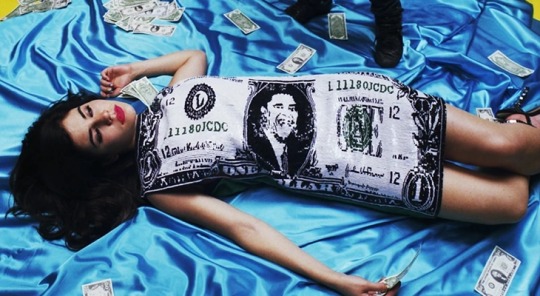
MUSIC VIDEO: "OH NO!"
‚Tis the season of reflection, and what better way to celebrate the spirit of Christmas than by delving into the mesmerizing world of Marina’s past fashion? This festive season, let’s take a stylish trip down memory lane and revisit the iconic fashion moments that have left an indelible mark on our style radar.
This Christmas, I can’t help but be inspired by the fabulous allure she exuded in the 2010 music video for "Oh No!" directed by the visionary Kinga Burza. The styling brilliance of Celestine Cooney played a pivotal role in creating an aesthetic that resonates even today.
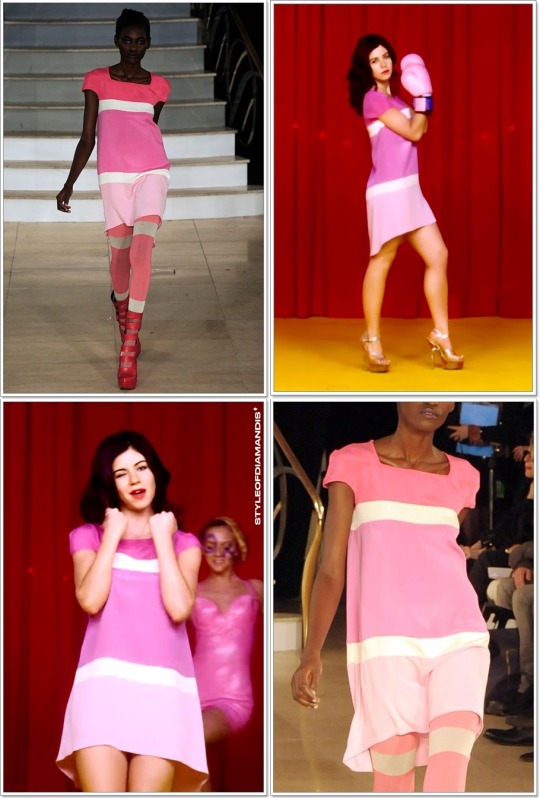
For the opening scene, Marina wore a pink color-block short-sleeved shift dress with horizontal stripes from the House of Holland Fall/Winter 2009 collection.
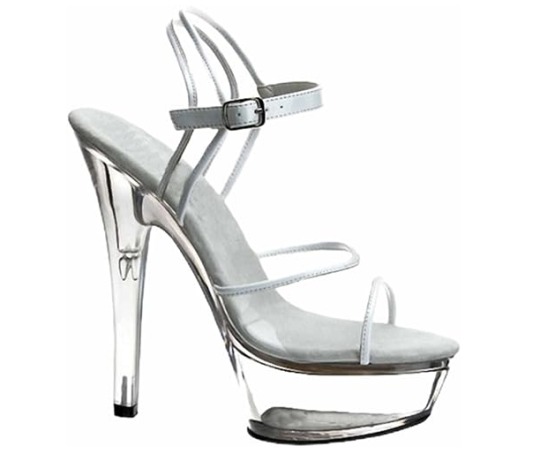
Marina completed look n. 1 with a pair of Pleaser Kiss 208-2 clear PVC platform sandals with silver piping.

Marina sported a second total House of Holland Fall/Winter 2009 look – cropped wool jacket with the matching pleated jodhpur trousers, both in an array of purple hues with contrasting white horizontal stripes. And peep those square-shaped buttons!
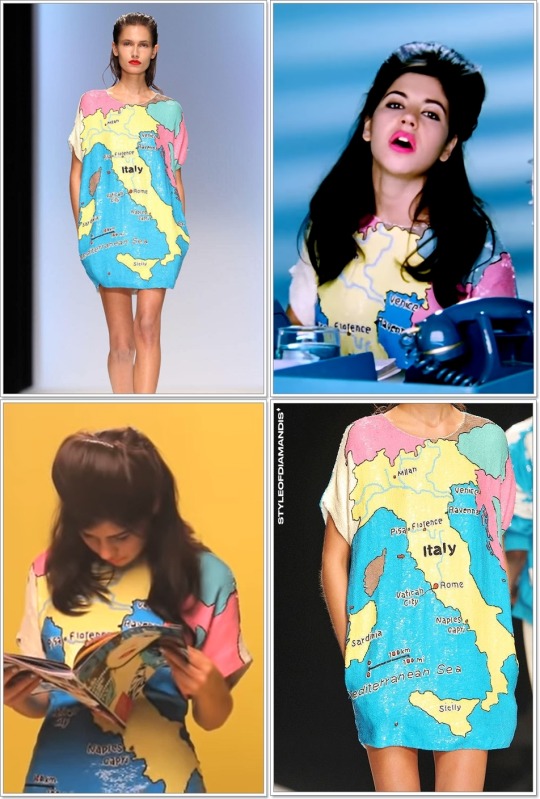
Indian designer Ashish used to be the most worn brand of hers during the "The Family Jewels" era so it's no surprise she incorporated some of his colorful sequin designs into the video.
From his Spring/Summer 2010 collection, Marina chose a kaftan-style mini dress depicting the map of Italy in bold, vibrant colors.
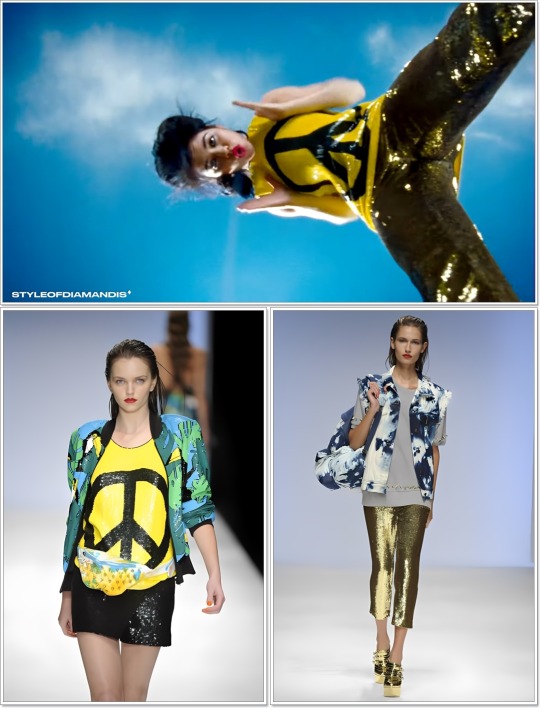
In a bunch of other scenes Marina is rocking the Ashish Spring/Summer 2010 yellow sequin peace sign sleeveless top and a pair of gold sequined capri trousers!
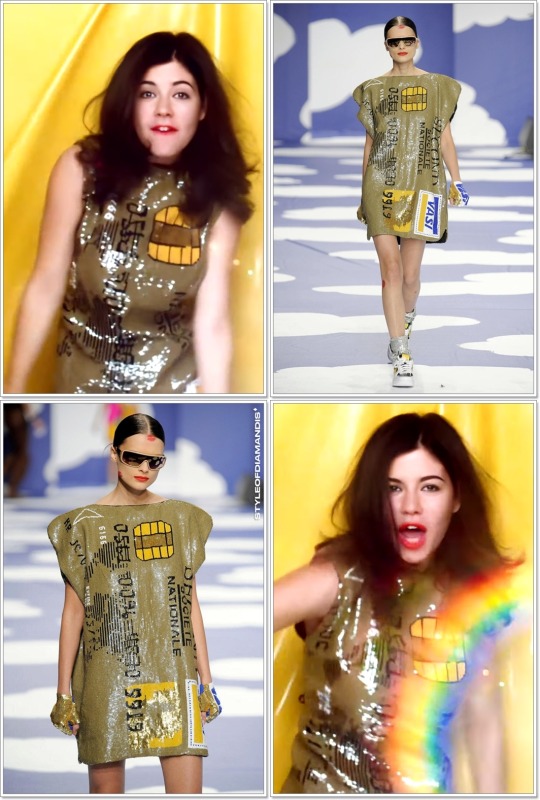
If you‘d ask me to describe this music video in three words, I'd say: fun, whimsical and CAMP!
Marina worked it in a gold sequin credit card dress from iconic French designer Jean-Charles de Castelbajac's Spring/Summer 2009 runway!
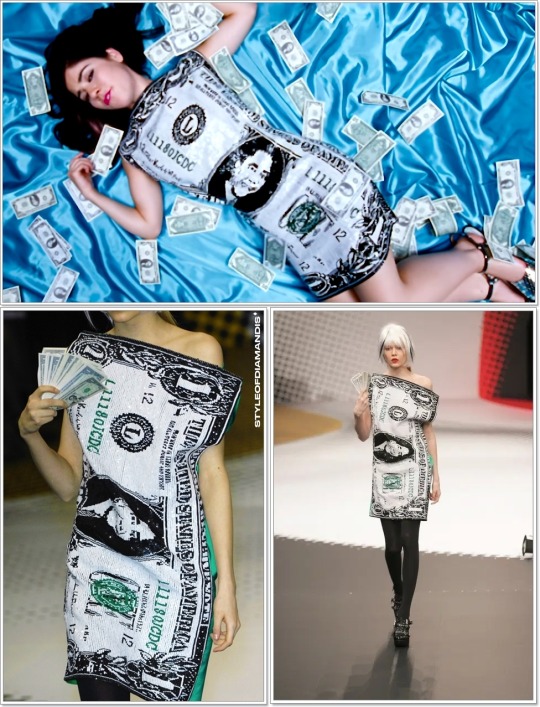
The second money-themed look by Jean-Charles de Castelbajac hails from his Fall/Winter 2009 collection. The cool detail about this dress, which you can‘t really see in these images, is that it has an turquoise silk backside!
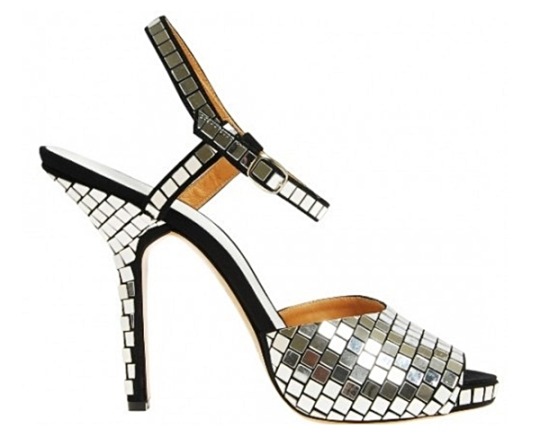
Those fabulous disco ball-inspired shoes belong to Maison Margiela's Spring/Summer 2009 20th-anniversary collection.
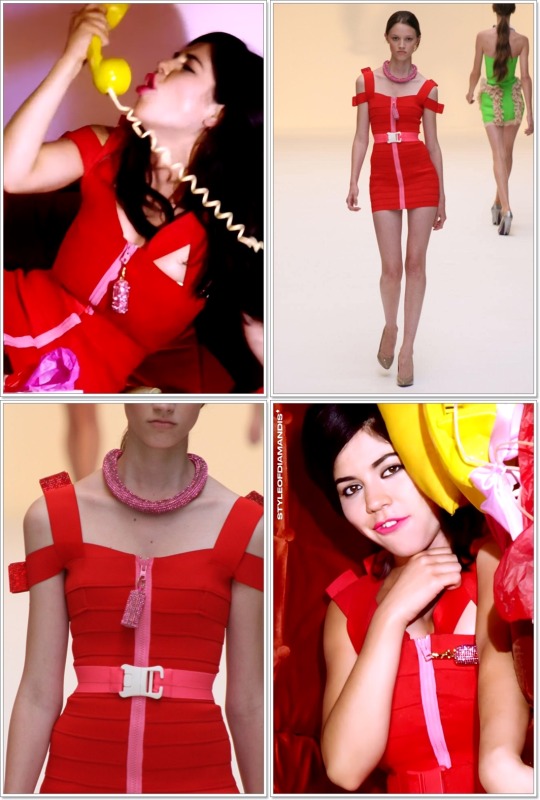
British fashion designer Christopher Kane also contributed to the "Oh No!" fashion by sending Marina few of his archival pieces, and my personal favorites on top of that.
Here, the Welsh-Greek beauty wore his Spring/Summer 2007 red bandage bodycon mini dress with crystal-embellished pill zipper in pink!

For the final lewk of the video, Marina danced, spinned and jumped around in the most adorable fuchsia crushed velvet mini dress from Christopher Kane's Fall/Winter 2007 collection which was inspired by Paul Delaroche's painting "The Execution of Lady Jane Grey" — and vindictive, man-eating women.

Thanks to this close-up, we can see that Marina wore a pair of insane Christian Louboutin Very Mix strass-studded platform peep-toe pumps in silver.
#June 2010#House of Holland#Jackets#Pants#Ashish#Tops#Christopher Kane#Jean Charles de Castelbajac#Dresses#Pleaser#Sandals#Maison Margiela#Christian Louboutin#Pumps
7 notes
·
View notes
Note
Do you have any images that portray St. Kateri more accurately?
I'm going to take this opportunity to respond to your earlier question re: diet as well. Kateri's avoidance of meat was not, in itself, a penitential practice, but it was intimately related to her celibacy, since in Haudenosaunee culture at that time access to venison had a lot to do with a man's, a husband's, role in the family structure. Without a husband Kateri would have had to scrounge for the results of the seasonal hunts rather than having implied access to them. The one time she went on one of the hunts herself, in the winter of 1677-8, was a traumatic experience for her (not for reasons related to hunting qua hunting; she was accused of sexual impropriety and it took weeks to clear her name).
Here's the only painting of her by someone who knew her in life, Father Claude Chauchetière SJ. Note that during her lifetime she would also have had a heavily scarred face from a childhood case of smallpox; this portrait represents her appearance in apparitions shortly after her death.

Note that she appears to have long, loose hair, but is covering it with a heavy blanket or mantle. The dress is also a bit more similar to conventional Euro womenswear than the "braids-and-buckskins" pan-Indian look she's conventionally depicted with today. This isn't necessarily due to European influence, although that is a possibility; Haudenosaunee women in this period seem to have dressed more or less like this in general.
16 notes
·
View notes
Text
Generic Cherokee stuff
From N. Bear, at the Cherokee Museum in North Carolina:
Traditionally, the people now known as Cherokee refer to themselves as Aniyunwiya (ah nee yun wee yah), a name usually translated as "the Real People," sometimes "the Original People."
The Cherokee never had princesses. This is a concept based on European folktales and has no reality in Cherokee history and culture. In fact, Cherokee women were very powerful. They owned all the houses and fields, and they could marry and divorce as they pleased. Kinship was determined through the mother's line.
Clan mothers administered justice in many matters. Beloved women were very special women chosen for their outstanding qualities. As in other aspects of Cherokee culture, there was a balance of power between men and women. Although they had different roles, they both were valued.
The Cherokee never lived in tipis. Only the nomadic Plains tribes did.
The Cherokee were southeastern woodland natives, and in the winter they lived in houses made of woven saplings, plastered with mud and roofed with poplar bark. In the summer they lived in open-air dwellings roofed with bark.
The Cherokee have never worn feathered headdresses except to please tourists. These long headdresses were worn by Plains Natives and were made popular through Wild West shows and Hollywood movies. Cherokee men traditionally wore a feather or two tied at the crown of the head. In the early 18th century, Cherokee men wore cotton trade shirts, loincloths, leggings, front-seam moccasins, finger-woven or beaded belts, multiple pierced earrings around the rim of the ear, and a blanket over one shoulder. At that time,
Cherokee women wore mantles of leather or feathers, skirts of leather or woven mulberry bark, front-seam moccasins, and earrings pierced through the earlobe only. By the end of the 18th century,
Cherokee men were dressing much like their white neighbors. Men were wearing shirts, pants, and trade coats, with a distinctly Cherokee turban. Women were wearing calico skirts, blouses, and shawls. Today Cherokee people dress like other Americans, except for special occasions, when the men wear ribbon shirts with jeans and moccasins, and the women wear tear dresses with corn beads, woven belts, and moccasins.
The Eastern Band of Cherokee Indians (EBCI) are descended from Cherokee people who had taken land under the Treaty of 1819 and were allowed to remain in North Carolina; from those who hid in the woods and mountains until the U.S. Army left; and from those who turned around and walked back from Oklahoma. By 1850 they numbered almost a thousand. Today the Eastern Band includes about 11,000 members, while the Cherokee Nation in Oklahoma claims more than 100,000* members, making the Cherokee the largest tribe in the United States.
Cherokee arts and crafts are still practiced: basket-weaving, pottery, carving, finger-weaving, and beadwork.
The Cherokee language is spoken as a first language by fewer than a thousand people and has declined rapidly because of the policies of federally operated schools. However, since the tribe has begun operation of their own schools, Cherokee language is being systematically taught in the schools.
Traditional Cherokee medicine, religion, and dance are practiced privately.
There have never been Cherokee shamans. Shamanism is a foreign concept to North America. The Cherokee have medicine men and women.
"aho" is not a Cherokee word and Cherokee speakers never use it. Most are actually offended by the misuse of this word. It's not some kind of universal Native word used by all tribes, as many believe. Each individual tribe have their own languages. We can respect these languages by using them correctly or not at all.
In order to belong to one of the seven Cherokee clans, your mother had to have been/be Cherokee and her clan is passed on to you. If the maternal line has been broken by a non Cherokee or someone had all sons, you have no clan, which is the case with many today.
There is only one Cherokee tribe that consist of three bands. The Cherokee Nation of Oklahoma, United Keetoowah Band of Oklahoma and the Eastern Band of Cherokee Indians of North Carolina. All others who claim a different band than one of the three above are not considered Cherokee and are a direct threat to Cherokee tribal sovereignty. In fact, to be Cherokee, one must be registered with the tribe, as Cherokee is a citizenship granted through documentation. One can have Native DNA but is not considered Cherokee until they are a registered tribal citizen.
via N. Bear
Cherokee man North Carolina
* Current tribal membership is 450,000 strong.
(From me: I'm not offended by 'aho'.)
5 notes
·
View notes
Text
Mods: The Progressives
Background on the 1960′s fashion world:
When you think of the 1960′s you most likely think of the fashion associated with Mods like shift dresses, mini skirts or go go boots as well as fashion icons like Twiggy, Jane Birkin or Nancy Sinatra. Between the 1950′s and 1960′s there was a transition in fashion as in the 50′s fashion was focused on French designers and was controlled around the wealthy elite. But with the new decade there was the creation of youth fashion where designers focused more on what young people were wearing. The cycle of fashion changed. It went from designers being copied by retailers to sell to consumers but they were taking inspiration from people on the streets and basing their design off of them. We also saw a shift in fashion capitals, London was fashions new muse, in particular Carnaby Street and in the Soho area in general.
Notable designers of the decade would be Mary Quant, Ossie Clark, Paco Rabanne, YSL, Givenchy and Andre Courreges to name just a few. Designers worked with man made materials to create their clothes and experimented with synthetics such as PVC and Polyester. Boutiques were made popular by Mary Quant setting up her first boutique in 1955. This was so that customers could combine items whilst still being accessible in urban environments like London.
Their seems to be a debate on who first created the mini skirt between Mary Quant and Andre Courreges when I was researching but some come to the conclusion that Andre created it whilst Quant popularised it. Breakfast at Tiffany’s was known for the black dress designed by Givenchy and created what we now know as “The Little Black Dress.” Now the most popular 60′s icons would be twiggy, Audrey Hepburn, Jean Shrimpton and Peggy Moffitt. However, people fail to mention Donyale Luna in that list, even though her impact has been important to the culture we know today. She was the first black women to appear on the cover of British Vogue and coined the first black supermodel. She also was reported as Andy Warhol’s and Salvador Dali’s muse. I recommend looking into her story.
Mods in the 1960′s:
Mods derived from the word modernists were teenagers from the baby boomer generation who’s families had benefited from the economic boom after WW2 in Britain. It was also a way to escape from the political issues that were going on at the time as they were seen as “adult problems” as it is reflected in the emphasis on being or dressing childlike as a divergence from adults. There were 3 stages of 60′s fashion. The early 60′s was the introduction of the ‘new look’ showing the new boxy silhouette that contrasts with the hourglass body type of the 50′s. Then there was the mid 60′s when the mini skirt and shift dress is introduced. In the late 60′s garments were more flowy, often associated with the hippies movement. This style was also influenced by south Asian clothing with pieces such as the Afghan coat coming from it as well as many patterns inspired from Indian clothing.
Bands like The Who, The Beatles and The Small Faces were influenced by this style as The Beatles were known for wearing skinny ties which were popular at the time. They were commonly associated with vespas as they were sleek and clean but also fast. A lot of teenagers preferred to go to coffee shops that opened late or jazz clubs. The style had evolved from their ancestors of the Teddy boys and ‘50s Betniks. Men’s style was influenced by suits from the Edwardian era as well as those of the French and Italian kind which were sharp and tailored. They also wore turtle necks and heavy jackets to survive UK winters. The women also wore clean lines and bright colours and controversial above the knee hemlines (Knees! How scandalous, How horrifying!) At the time they were seen as progressive which on reflection can seem quiet shocking for how far we have come today, even though today is far from perfect. The style to some extent was seen as quiet androgynous with women adopting short hair styles and were becoming more independent as the second wave of feminism influenced ideas of women in the 1960′s as women believed that they should build a life outside of the home. This style was quiet popular to say it was a subculture but it did also clash with the equally popular rocker crowd of the time in England.
When writing this I thought back to trends have realised that the 60′s in fashion has forever impacted culture but the mods can still be seen today in terms of trends with bright pastel colours and mini skirts being a forever staple. Although now I believe that there has grown to be subcultures but also an emphasis on personal style. There are so many icons from this decade that I wish I could all mention and explore. Not only in fashion but in music as well.
Hey guys, sorry it’s been a while, been focusing on school. I hope you are all doing well. Thank you for the love on my last post, I really appreciate it!!! Hopefully I will post more soon.
Lots of Love,
~Siren~ <3
#twiggy#60s fashion#fashion#fashion trends#fashion history#mary quant#paco rabanne#emilio pucci#nancy sinatra#jane birkin#the beatles#the who#vintage#donyale luna#historic fashion#history#london#audrey hepburn#breakfast at tiffany's#little black dress#mini skirt#shift dress#suits
19 notes
·
View notes
Text
Yes, Here Is A Blog Post On Women’s Fashion Tips For Your
KurtiBazzar
Female Fashion Suggestions
Using Your Own Unique Sense Of Style And Expression Using Fashion. But Developing Looks That You Love May Also Be Expensive And Time-Consuming. The Use Of Fashion Hacks Is Then Important. Simple Advice And Techniques Known As “Fashion Hacks” Can Make You Look Your Best Without Breaking The Cash Or Takes Hours To Get Dressed
Here Are A Few Tips For Women’s Fashion:
1. Accessorize. Any Ensemble Can Benefit From The Personality And Style That Accessories Provide. A Simple Outfit Can Be Improved And Made More Original With A Touch Of A Statement Scarf, Necklace, Or Pair Of Earrings.
2. Add And Subtract. Do Not Be Scared Of Merging Various Things From Your Clothing Collection. Mixing Various Colors, Textures, And Patterns Will Help You Create Modern And Interesting Looks.
3. Add Layers. In The Winter, Layering Is An Excellent Way Of Maintaining Warm And Give Your Outfits A Greater Depth. Think About Wearing A Sweater Over A Dress Or A Tank Top Under The Button-Down Shirt.
4. Shop At Bargain And Resale At Thrift Stores And Consignment Shops, You May Get Great Prices On Clothing, Shoes, And Accessories. Frequently, You Can Discover Unique Products Which Are Prohibited Elsewhere.
5. Keep Your Clothes Looking Clean. To Keep Your Clothes Looking Their Best, Wash And Iron Them Regularly. In Addition, You Should Take Care Of Your Clothing Carefully To Avoid Fading And Wrinkles.
Here Are A Few More Special Fashion Tips:
1. Use A Belt Having Both Faces To Create Two Distinct Looks. The Belt May Display A Modest, Hidden Side And A More Expressive, More Noticeable Side.
2. Use A Scarf To Make A Skirt Or Top. A Scarf Can Be Knotted In A Number Of Ways To Create Distinctive Clothes. Online Or In Fashion Magazines, You Can Find Tutorials.
3. To Prevent The Straps On Your Bra From Showing, Use A Safety Pin. A Safety Pin Can Be Used To Secure The Straps Of A Strapless Bra To The Back Of A Dress Or Blouse.
4. Keep Your Clothes In Place With The Help Of Tape With Two Sides. Use Double-Sided Tape To Keep A Low-Cut Dress Or Skirt From Slipping Down When You’re Wearing It.
5. To Remove Cotton And Animal Fur From Your Clothing, Use A Lint Brush. No Matter How Short For Time You Are, This Will Help You Look Your Best.
These Represent Just A Few Women’s Fashion Tips. You May Find Even More Ways To Save Time And Money On Clothes With A Little Creativity.
Incorporating Some Clever Fashion Hacks Can Help You Make A Lasting Impression On Your First Date. First Date Fashion Advice
If You Follow Women’s Fashion Tips Check Accessories Here.

2 notes
·
View notes
Text
As the new season approaches, the fashion world gears up to embrace new trends that blend the warmth of tradition with modern aesthetics. The AW24 womenswear collections promise an array of styles that cater to both classic and contemporary tastes. This season, ethnic wear takes center stage, highlighting cultural influences while incorporating innovative designs that make each piece stand out. From the rich hues of festive attire to the subtle sophistication of everyday wear, here's your ultimate guide to the top AW24 trends in womenswear.
#Autumn Winter 2024#Autumn Winter 2024 Collection#Autumn Winter 2024 fashion trends#AW24 Collection#AW24 Collection Lookbook#AW24 fashion trends#Autumn Winter 24 trends#Autumn Winter trends#AW24 trends womens wear#AW24 trends womenswear#best ethnic wear online#designer ethnic sets for ladies#Designer Autumn winter 2024 Collection#best indian ethnic wear online#Collection of AW24#designer ethnic sets#designer ethnic sets for women#ethnic fashion trends#ethnic kurtas for ladies#designer indian ethnic wear online#ethnic kurta sets#ethnic sets for women#ethnic sets with pant#ethnic suit sets online#fashion trends for women#festive ethnic dresses#festive ethnic wear#festive ethnic sets#festive ethnic wear online#fresh arrival kurta set
0 notes
Note
Happy WBW, lovely! Not sure why, but today I'm asking about fashion?? What does the fashion-- I'm talking high, street, or anything else-- look like in your world(s)?
Happy WBW, Tori!
I answered something similar to this here, but I'll add a little more since I didn't talk about fashion overall.
To summarize, it's all over the place haha. Some of this is purely self-indulgent/anachronistic, but also because despite being a medieval-ish setting, this is also a setting where magic exists AND also one where there is a wide variety of cultures and people who live in varied climates with access to different native fibers and manufacturing techniques. Not to mention there are significantly different body shapes. That is, not everyone has proportions, sexually dimorphic traits, or limbs that fall into the usual humanoid shape, so naturally, their fashions would be different. And even amongst people of the same race, there is a huge variety in what they wear depending on where they live. However...
We can assume the following:
Humans: Garments are similar to what you might find in 17th-century European fashions for those that live in large cities or relatively populous areas. Stays, padding, shifts, petticoats, hoops, bonnets/caps, etc. Of course, the materials, colors, etc all vary by region, wealth, occupation, you get the idea. For those that live most remotely (countryside, small islands, etc), their clothes are homemade and focused on durability rather than on a fashionable shape (which the aforementioned is considered to be), so are more gender neutral. Trousers, durable shirts, cloaks, ponchos, and usually some kind of durable leather shoe (can be a sandal or boot depending on the climate), and head coverings are popular.
Lizardfolk: Each house has a style they prefer. House of War prefers styles similar to traditional Thai dress, the House of Law prefers styles similar to 17th-century Japanese garments, and the House of Dreams prefers styles similar to Mughal period Indian fashion. Their winter wear, when they have need of it, is heavily inspired by Mongolian fashion. Additionally, corsets are favored by women of the Holtep Empire. These are not the undergarments you might imagine for people, nor are they worn all the time, usually only for special occasions and usually only by the nobility. They are worn with special robes that expose the midriff and are made of steel. They are more like armor than anything else, and unlike human corsets are meant solely for aesthetic purposes; they don't support breasts (bc they don't have any) and are intended to emphasize how small a woman's waist is. It is the most desired of traits in the Empire.
Dwarves: Heavily inspired by a variety Native American dress. I am still fleshing this out a bit, but their clothing is focused on durability, ease of movement, bright colors, and heavy decorative elements.
Elves: Probably the widest variety because of how scattered their kingdom is. They are known to borrow elements of the fashions listed above. However, their 'base' is most similar to ancient Mayan and Aztec fashion.
3 notes
·
View notes
Text
My Style Analysis: Devi, Kamala, and the Disastrous Dinner
Some spoilers ahead

Can anyone notice a similarity in their costumes? (Blame it on my many readings of Tom & Lorenzo's Mad Style, The Crown Style, Mrs America Style, etc.)
Both are wearing light cardigans over tank tops and patterned, floaty skirts. With rather domestic concerns (Devi is concerned about making sure her mother doesn't miss her chance with a romantic prospect despite her own conflict with that prospect's daughter while Kamala is concerned that their granny's new beau could be taking advantage of her wealth). Devi is caught between taking her cousin's usual role of serenity and her own conflict with Margot (note Margot's dress looks similar to Devi's skirt): she is all patterns and rich colors except for the tank top under her cardigan which ties her to Kamala.
Kamala is armored in neutral and pastel tones, managing to look more modest than even her grandmother and aunt, likely signaling she put her own romance and ambitions on the back burner for the sake of her grandmother (and her own failure to launch). The roses of her skirt may nod to her being surrounded by romantic and sexual tension around her, along with a clinging to what she is familiar with (the maternal and comforting roses of her family). This is contrasted with the busy prints of Devi's skirt and the argyle on her cardigan, who manages to show a bit more skin than her cousin while dealing with a prospective suitor whose appearance throws a wrench into her plans to help mend fences for her mother's happiness.
There is also a fair amount of cleavage showing with cardigans that aren't closed, likely signaling these two are young women who are exploring their sexuality and coming into their own while their widowed mother/aunt and grandmother step out of their traditional roles to find love after 40; this is pointed as Devi's suitor Ben confessed to friend Trent about his dream of Devi as both an intellectual equal (if not superior) and her physical appeal while Kamala is somewhat "off the market" due to her beau Manish being across the country. One can be cheeky and paraphrase my Mother as saying they both have Mommy bosoms (comforting place for a child to rest their head), hoping to pad any fall their maternal figures may end up having.

The Seasons look represented: Nalini in the Autumn of her life in dark tones that make her look commanding and comforting and practical in slacks, Kamala in the Summer of her life and in danger of fading into her clothing/comfort zone if she doesn't step up for her life, and Devi in the blooming Spring learning to slow down before launching herself and take a step back. This all in contrast to the pale tones worn by Nirmala who doesn't fade into them and reconciles the whites of her past mourning (white being a color of mourning in Indian culture) and the whites of her beau's culture (a bridal look), she is in the Winter of her life and is embracing it as a new stage in her life and a second youth.
As an aside....
I, as a child of the 90s and 00s, would not be remiss to miss that I love Richa and Maitreyi have real bodies that bloat and have curves. Since I was young, many peers freaked if our thigh gaps weren't wide enough or if we had something to pinch on our bodies or didn't have washboard abs, add super weight conscious and ignorant elders poking at us and media images of very thin and scary toned people and it's no wonder I was 30 when I learned it's often rare to be both busty and very thin, and that if you had a small waist with round hips, it's impossible to have a six-pack. Or that stomach padding is used to pad the reproductive organs and cis women carry more weight in our hips, thighs, and buttocks. Also a cruddy healthcare and education system.
#women in media#costume analysis#fashion analysis#never have i ever#devi vishwakumar#kamala nandiwadal#tom and lorenzo#benvi
5 notes
·
View notes
Text
The Ultimate Bridesmaid Checklist
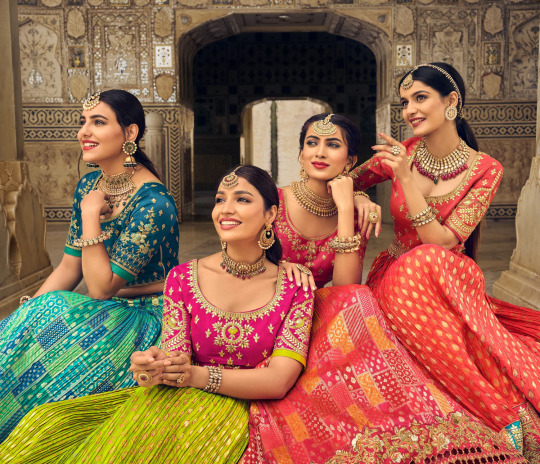
Being a bridesmaid is an exciting and important role in a wedding, and one of the most crucial decisions you'll make is selecting the perfect attire. From the exquisite wedding lehengas to trendy bridesmaid dresses, it's essential to plan ahead and ensure that you look your best while complementing the bride's style. In this blog post, we'll provide you with a comprehensive bridesmaid checklist to help you navigate through the process of finding the ideal dress for various wedding events, including engagement ceremony, weddings, and more.
Wedding Theme and Dress Code:
Before starting your hunt for the perfect bridesmaid attire, understand the wedding theme and dress code. Aligning your Indian dress with the overall ambiance of the wedding is of utmost importance. Whether it's a traditional or modern affair, knowing the theme will guide your choices and help you select an appropriate ensemble.
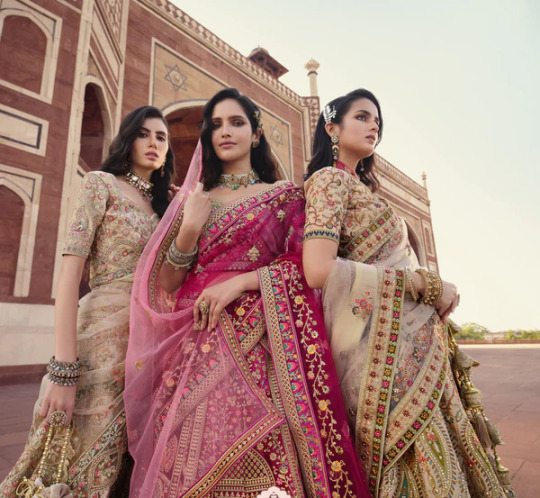
Explore Bridal Lehengas:
While the bride will be the center of attention in her bridal lehenga, you can complement her look by choosing a bridesmaid lehenga that complements the bride's outfit and matches the wedding color palette. Consider the bride's preferences and coordinate with her to find a lehenga that strikes the perfect balance between individual style and overall harmony.
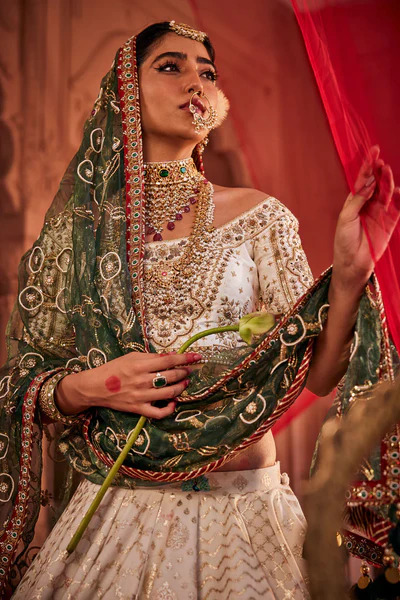
Bridesmaid Dresses for Indian Weddings:
If the wedding calls for Indian dresses, explore a range of bridesmaid dresses that suit the occasion. Consider the wedding's color scheme and preferences while choosing a dress that flatters your body type. You can opt for various styles such as flared lehenga choli for women, long flowing, frock style Anarkali Suit, Two piece outfit like Sharara, Croptop, floor length Gowns keeping in mind the bride's overall vision and your own comfort.
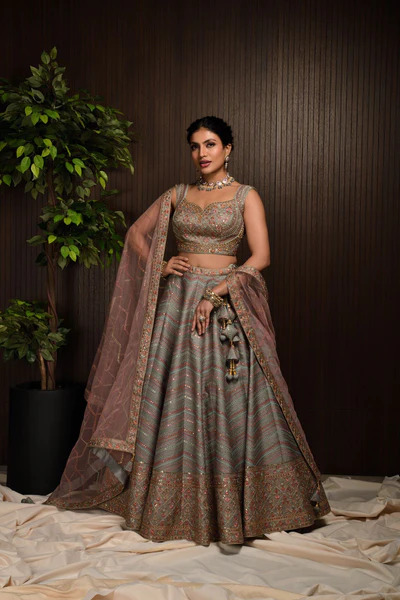
Dresses to Wear to Weddings:
Apart from the main wedding event, there may be additional occasions like engagement ceremonies, Haldi ceremony, cocktail parties, and sangeet nights. Plan your wardrobe in advance, considering the specific dress codes for these events. Explore elegant and fashionable options like Anarkali dresses, indo-western fusion outfits, or contemporary gowns that reflect your personal style and the ambiance of the event.

Wedding Wear Dresses for Different Seasons:
Consider the season and climate when selecting your bridesmaid dress. Opt for lighter fabrics and breathable materials like chiffon or georgette for summer weddings, while velvet or silk blends work well for winter weddings. Choosing weather-appropriate dresses will ensure you're comfortable throughout the festivities.

Accessories and Footwear:
Complete your bridesmaid ensemble with the right accessories and footwear. Coordinate with the bride and other bridesmaids to maintain a cohesive look. Choose accessories like statement jewelry, elegant clutches, and stylish footwear that complement your dress and elevate your overall appearance.
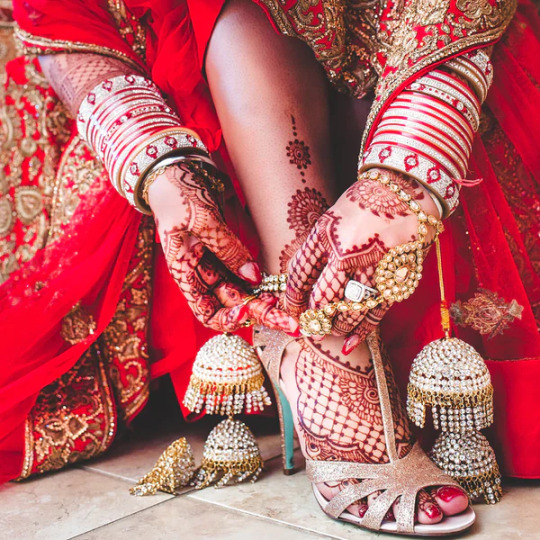
Alterations and Fittings:
Ensure you have ample time for alterations and fittings to ensure your bridesmaid dress fits perfectly. Schedule appointments with a trusted tailor or boutique well in advance to avoid any last-minute alterations. This step is crucial for achieving a polished and well-fitted look on the wedding day.
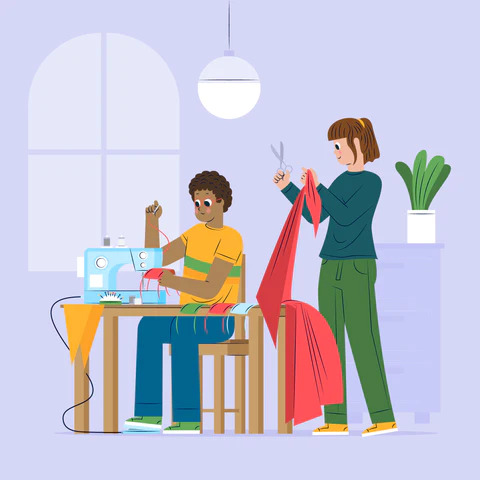
Being a bridesmaid is a privilege, and selecting the perfect wedding wear dresses is a key aspect of fulfilling your role. By following this comprehensive bridesmaid checklist, you can confidently choose a stunning lehenga or dress that reflects your style, matches the wedding theme, and complements the bride's ensemble. Remember, your role is to support and enhance the bride's special day while looking and feeling your best. With careful planning and attention to detail, you'll be a picture-perfect bridesmaid at the upcoming wedding celebrations.
#indianwedding#lehenga#indianfashion#wedding#bride#ootd#ethnicwear#indian ethnic wear#designer#ethniclove
1 note
·
View note
Text
Ethnic Wear for Women: A Complete Guide to Timeless Elegance
As worn by women in ethnic wear is a celebration of tradition, culture, and beauty. From delicate needlework on stylish suits to crisp kurta sets, ethnic fashion brings comfort alongside elegance. Wedding wear, celebrating occasions, and daily wear require the diversity seen in ethnic styles. At Vayusut, we take pride in a well-curated collection of the most beautiful, trendy ethnic clothes, blending all traditional aesthetics in a modern blend.
In this guide, we will lead you through several types of ethnic wear, ranging from suits for women to salwar suits and kurta sets, designer kurtas, and many others. This should guide you about choosing the best outfit for whatever occasion.
Ethnic Wear-Some Everlasting Charm
Every woman has ethnic wear in their wardrobe. Though it is India's rich heritage, ethnic wear is evolving and keeping pace with the changing fashion trends of modern times. Ethnic fashion is always in fashion-whether it is a stylish designer kurta set that comes heavily needlework for women or a simple and stylish cotton kurta.
The ladies of the present day require a combination of tradition and comfort in the clothing. Sarees and kurta sets continue to dominate the scene, but suits and kurta sets are slowly but surely gaining acceptance with many women, primarily due to their flexibility and comfort level. Let's have a look at the ethnic wear section and what must be present in the wardrobe.
Types of Ethnic Wear for Women
1. Women's Suits: Versatility and Elegance
Suits for women have always been a staple in Indian ethnic fashion. They provide comfort, flexibility, and numerous styles to choose from. Whether it is a formal event or a casual outing, your chosen suit will surely add to your style fluently.
Popular Suit Styles:
Straight-Cut Suits: Great for office wear or formal occasions, these suits have a sleek and elegant appeal.
Anarkali Suits: These are the flowy and regal-looking suits perfect for wedding and all other similar celebrations.
Pakistani Suits: These suits have a long straight-cut design with deep embroidery. This one's perfect for a classic look.
Patiala Suits: These suits consist of pleated Patiala salwars, giving that vibrant and traditional Punjabi touch.
Winter Suits for Women: Wool or pashmina laced winter suits are perfect to look fashionable even during the colder season.
2. Salwar Suit for Women: Timeless Traditional Wear
Salwar suits are one of the most common and favorite ethnic wears among women. It consists of a kameez (top), salwar (bottom), and a dupatta (scarf) along with it. Hence, the salwar suit can be opted for various functions and occasions.
Some of the styles of salwar suits include:
Churidar Salwar Suit: It comprises a long kameez with a fitted churidar bottom.
Palazzo Salwar Suit: They are very comfortable and stylish, comprising a straight-cut kameez and broad-legged palazzo pants.
Cotton Salwar Suit: It is quite good for everyday use, especially in the summer, and it is also pretty cool and comfortable.
Designer Salwar Suits: They will be studded with embroidery, sequins, and beads and will be suitable for special occasions.
3. Women Kurta Set: Novel Approach to Ethnic Style
The kurta set for women is a fashionable and comfortable alternative to traditional ethnic wear. It consists of a kurta paired with trousers, palazzos, or leggings. Kurta sets can be worn casually or dressed up for festive occasions.
Trending Kurta Styles:
Cotton Kurta: A must-have for summer, offering breathability and style.
Chikankari Kurta Set: Features intricate Lucknowi embroidery, ideal for casual and festive wear.
Designer Kurta Set for Women: Sequins, beads, and embroidery adorn it, giving a sleek look.
Kurti Set with Dupatta: Perfect set coming with ethnic jewelry.
Black Kurta Set for Women: Very versatile and an ageless trend for any occasion.
4. Formal Ethnic Wear for Women: Traditional Attire for Work & Events
Workplaces are welcoming formal ethnic wear for women these days, helping them to preserve their tradition without losing the professionalism.
Best Formal Ethnic Outfits:
Straight-Cut Kurta with Trousers: Simple yet elegant, working dress.
Cotton Kurti with Dupatta: Soft and glamorous for workplaces
Anarkali with Light Embellishments: Best for marriages and other celebrations events
5. Best Ethnic Wear for Women's Weddings and Festive Occasions
Indian marriages and festivals require elaborate dresses with heavy needlework, sequins, and zari work. The best ethnic wear for women during the festive season is:
Anarkali Suits: Ideal for a royal and elegant look.
Heavy Designer Suits: Made of luxurious fabrics and intricate embroidery.
Pakistani Suits: Richly crafted and detailed.
Chikankari Kurta Sets: Subtle yet stylish for festive wear.
6. Best Kurta for Women: Finding the Perfect Style
Kurta for women: it depends on the occasion and personal style. You can go for a cotton kurta set for daily use or a heavily embellished designer kurta set for women on weddings. So, there is no dearth of options here.
Must-Have Kurta Styles:
Cotton Kurta: Lightweight and breathable, great for summer.
Black Kurta Set for Women: A must-have in every wardrobe.
Chikankari Kurta Set: Elegant and trendy.
Kurti Set with Dupatta: A ready-to-go outfit for festive occasions.
How to Style Ethnic Wear for Different Occasions
Casual Wear
Opt for a cotton kurta or a simple salwar suit with minimal embroidery.
Pair with juttis or sandals for a comfortable look.
Work Wear
Choose formal ethnic wear for women like a straight-cut kurta with trousers.
Keep the accessories minimal for a professional look.
Festive & Wedding Wear
Go for a heavily embroidered Anarkali, designer suit or Pakistani suit
Pair with the statement jewelry that is embroidered and traditional juttis.
Where to Buy Best Ethnic Wear For Women?
The search for great quality and stylish ethnic wear has become effortless. Vayusut presents an exclusive collection of ethnic wear, from kurta sets to designer salwar suits, ensuring you find the perfect outfit for every occasion. From wedding suits for women to party wear, formal ethnic looks, or any other fashion and comfort attire, there's something for everyone in our collection.
Why Choose Vayusut?
We have high-quality fabrics to provide the highest level of comfort and style.
Our collection is updated with the latest fashion trends.
Get luxurious ethnic wear without burning a hole in your pocket.
Browse through our website to have a hassle-free shopping experience.
Conclusion
Ethnics for women-that is the most current trend in fashion, and it will not fade. From suits for women, salwar suits, and an ethnic kurta set, there's something pretty, beautiful, or simplistic ethnic outfit for every occasion. But with Vayusut's high-quality and stylish ethnic wear, embracing tradition and being in vogue becomes very easy for you. Look at our collection today and raise your ethnic wardrobe with ease!
#suitsforwomen#suitdesignforwomen#salwarsuitforwomen#Pakistanisuitsforwomen#Anarkalisuitsforwomen#Cottonsuitsforwomen#Designersuitsforwomen
0 notes